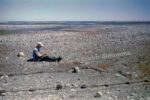Archive contact:
Patricia Fried
lawrencefried.com
LAWRENCE FRIED (1926-1983)
Larry, as he was known throughout the industry, was an award-winning photojournalists, who covered the political, social, and artistic events of his time for top publications such as The New York Times, Newsweek, The Saturday Evening Post, Vogue, Collier’s, and Parade Magazine. Fried became interested in photography while serving as a platoon sargeant with the First Infantry Division during World War II. Using an old camera found on the battlefield, Fried took shots of the battle action and was surprised to learn they were sold to a wire service. Influenced by wartime imagery, he returned to the States and went to the University of Miami on the GI Bill becoming a theatrical director and photographer.
He returned to his native New York City where he immersed himself its theatrical world, shooting for the Pix Photo Agency. After a quick stint on staff for LIFE, he became a dedicated free-lancer. In his thirty year career he covered a wide range of stories from theatre for the New York Times to three trips into Viet Nam and Cambodia to world leaders such as Chang Kai-shek and President John F. Kennedy. A favorite of the Kennedys, Fried photographed JFK, Robert Kennedy, Ted Kennedy and Jacqueline Kennedy. His Newsweek cover of RFK was chosen for the cover of To Seek A Newer World. His photograph of a mourning Jacqueline Kennedy along with “The Three Rabbis” are in the permanent collection of the Smithsonian Institution. While riding in the presidential motorcade covering Lyndon Johnson in1964 for the Saturday Evening Post, his car caught on fire and his leap was captured on the front page of many major newspapers throughout the world including The New York Daily News.
Throughout his career, he photographed an extensive list of musician, actors, and visual artists such as: Louis Armstrong, Bob Dylan, Bette Midler, Mick Jagger, Stevie Wonder, Meryl Streep, Marilyn Monroe, Brando, James Dean, Shirley McClaine, Andy Warhol, Richard Serra, and Willem DeKooning. Fried had the distinction of having photographed the most Newsweek covers in the history of the magazine.
Fried was a three-term president and 32 year member of the ASMP, the American Society of Magazine Phtographers, a trade organization and was instrumental in the development of the first Business Practices book in 1973.
In 1975, Fried co-founded The Image Bank calling on friends such as Jay Maisel, Pete Turner, Walter Iooss, and Douglas Kirkland to join. The Image Bank quickly became the premier agency of its kind with franchises all over the world. TIB created a new model of selling stock photography that is followed to this day. Getty Images bought the company in 2000.
Awards. Fried was the recipient of the Photographer of the Year award by the Overseas Press Club, the prestigious Benjamin Franklin Award and the Outstanding Service to ASMP award. For the first time in five administrations, President Dwight Eisenhower granted an exclusive photographic interview with Fried. The resulting photographs earned him the Benjamin Franklin Award for 1959. In 1960 he received the Overseas Press Club Photography Award for outstanding interpretation of foreign news for a series about life in Siberia growing out of his two trips to the Soviet Union where he covered 50,000 miles of Russian territory by train. The idea for the trip came to him after his camera was smashed by a guard at Moscow airport. He was offered an official apology. He refused it and requested special permission for a trans-Siberian trip instead. His request was granted.











































